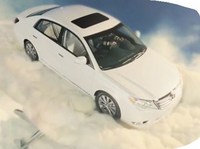2011 Toyota Avalon Review
SEE ALSO: Toyota Buyers Guide
THE AUTO PAGE
By JOHN HEILIG
SPECIFICATIONS
Model: 2011 Toyota Avalon
Engine: 3.5-liter DOHC V6
Horsepower/Torque: 268 hp @ 6,200 rpm/248 lb.-ft. @ 4,700 rpm
Transmission: 6-speed automatic with Sequential Shift
Wheelbase: 111.0 in.
Length/Width/Height: 197.6 x 72.8 x 58.5 in.
Tires: P215/55R17 (full-size spare)
Cargo volume: 14.4 cu. ft.
Fuel economy: 20 mpg city/29 mpg highway/15.8 mpg overall
Fuel capacity: 18.5 gal.
Curb weight: 3,572 lbs.
Sticker: $35,984 (includes $750 delivery processing and handling
fee; and $2,989 in options)
The Bottom Line: The new Toyota Avalon may be retro in its ads, but it’s all modern in its appeal, with a reasonably powerful engine, interior roominess and Lexus-like quiet operation, all with a reasonable price (compared to Lexus).
As one who has been dragged grudgingly into the 21st Century, I’m a big fan of the retro ads used for the Toyota Avalon. Who doesn’t want to back to an era where airplane passengers dressed up, where flight attendants (stewardesses then) treated people like guests, and where driving was a fun experience, similar to driving through clouds?
That’s the first impression one gets from the Avalon. It is incredibly quiet and smooth. So much so, that I had to check a few times to see if it had a Lexus badge instead of a Toyota one. I believe the Avalon designers stole a few pages from their counterparts at Lexus when they drew up the Avalon, and they were the right pages to steal.
Start the 3.5-liter V6 with the pushbutton start – no, wait, there’s no pushbutton – but it feels as if there should be a pushbutton. The instrument panel – white-on-black with white pointers – comes on with the ignition.
The engine is quiet, yet it has plenty of power. There’s some engine noise on hard acceleration, but that’s to be expected. It is almost silent under normal operation, though.
On the road, the Avalon handles well, but ride quality is tuned for comfort. This isn’t a good car to test on a tight winding road, although it won’t wallow around like the cars in the retro era.
For reversing, there’s a back-up camera that is clear. I prefer the addition of “turning lines,” but maybe Toyota is saving them for the Lexus version.
The front seats don’t offer great side support, but they’re leather and heated, so that’s a wash. The driver and front passenger face a standard audio readout and a navigation system that’s clear and easy to program once you figure it out. The Navi system can also list directions, so you can modify them if you want.
There’s a USB/AUX connection the console/arm rest if you can’t live without you iPod (hey, even us oldies enjoy pre-programmed music.
Toyota makes a big thing about their “reclining” rear seats. Well, they recline about as much as an economy class plane seat, but they do recline. More important, there is very good leg and knee room and enough hip and shoulder room for five passengers, even if one or two of them is on the large economy size.
Among the definitely “non-retro” features of the Avalon is storage. There’s a good trunk with a remote on the dash and key fob to open it. It has a pass-through to the back seat. The rear seats also fold to increase trunk capacity. Besides a host of cupholders inside the Avalon, there are water bottle holders in the trunk if you’re carrying a sixth passenger back there.
Additional storage includes two covered cupholders in the center console; a deep cubby behind the center console with an insert that holds a cell phone; a deep cubby at the base of the center stack; hinged doors over the door pockets; and a standard glove box.
The ultimate take-away from the Toyota Avalon is its smoothness, which can’t be overstated. In this case, the retro ads are right, although modern jets are quieter than retro-era props.
© 2010 The Auto Page Syndicate



